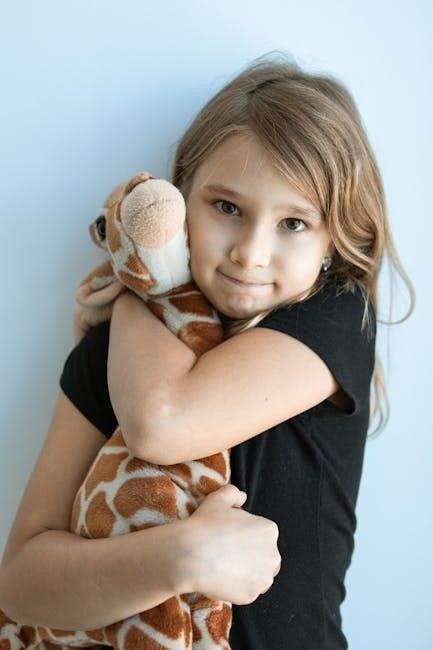Article Plan: Attachment Style Assessment PDF
This article explores attachment style assessments utilizing PDF resources. We will delve into attachment theory‚ its relevance in adulthood‚ and various attachment styles. Furthermore‚ we will examine self-report questionnaires like the ECR‚ focusing on their interpretation and application for understanding relationship dynamics.

Attachment styles‚ deeply rooted in early childhood experiences with primary caregivers‚ significantly shape how individuals form and maintain relationships throughout their lives. These styles‚ developed within the crucial early relationship‚ influence our expectations‚ behaviors‚ and emotional responses in intimate connections. Misattunement in these formative relationships can lead to the development of insecure attachment patterns.
Understanding attachment styles provides valuable insights into romantic commitment and the dynamics of interpersonal relationships. Attachment is an innate behavioral system that plays a crucial role in how we form and experience connections. The exploration of attachment styles allows for a deeper understanding of our own relational patterns and those of others.
Attachment theory emphasizes the importance of early experiences in shaping later relationship outcomes. Recognizing and understanding these styles are essential for fostering healthier and more fulfilling relationships‚ leading to increased self-awareness and improved interpersonal interactions. This introduction sets the stage for a comprehensive exploration of attachment styles and their impact.
Overview of Attachment Theory
Attachment theory‚ a cornerstone in understanding human relationships‚ posits that early interactions with primary caregivers shape our expectations and behaviors in later relationships. This theory emphasizes the innate behavioral system that drives us to seek and maintain close connections. The core idea revolves around the impact of early bonding experiences on our relational patterns.
Attachment theory has been empirically validated and continues to evolve‚ providing valuable insights into various aspects of human behavior. It suggests that the quality of early caregiving experiences significantly influences the development of different attachment styles. These styles‚ in turn‚ affect how we approach intimacy‚ trust‚ and emotional expression in our relationships.
Understanding attachment theory is crucial for comprehending the underlying dynamics of romantic commitment and interpersonal relationships. This framework allows us to explore how early experiences contribute to the formation of secure or insecure attachment patterns. By examining these patterns‚ we gain a deeper understanding of our own relational tendencies and those of others.
Attachment Styles in Adulthood
Attachment styles‚ formed in early childhood‚ significantly influence adult relationships‚ impacting romantic partnerships‚ friendships‚ and even professional interactions. These styles dictate how individuals approach intimacy‚ conflict‚ and emotional expression. Understanding these patterns is crucial for fostering healthier and more fulfilling connections in adulthood.
Adult attachment styles are categorized into secure and insecure types. Securely attached individuals tend to have trusting and balanced relationships‚ comfortable with both intimacy and independence. Insecure attachment styles‚ such as anxious-preoccupied‚ dismissive-avoidant‚ and fearful-avoidant‚ often lead to challenges in forming and maintaining stable relationships.
Anxious-preoccupied individuals crave closeness and fear rejection‚ while dismissive-avoidant individuals prioritize independence and suppress emotional needs. Fearful-avoidant individuals desire intimacy but fear vulnerability and rejection. Recognizing these diverse manifestations of attachment styles in adulthood enables individuals to navigate their relationships with greater awareness and empathy‚ promoting personal growth and healthier interpersonal dynamics.
Types of Attachment Styles
Attachment theory posits that early childhood experiences shape our relational patterns‚ leading to distinct attachment styles. These styles‚ primarily categorized as secure and insecure‚ significantly influence how we approach relationships throughout our lives. Understanding these categories is crucial for self-awareness and fostering healthier connections.
Secure attachment‚ characterized by trust and emotional availability‚ allows individuals to form balanced and fulfilling relationships. Insecure attachment styles‚ on the other hand‚ stem from inconsistent or unreliable caregiving‚ leading to difficulties in intimacy and emotional regulation. These styles include anxious-preoccupied‚ dismissive-avoidant‚ and fearful-avoidant attachment.
Anxious-preoccupied individuals crave closeness but fear rejection‚ often exhibiting clingy behavior. Dismissive-avoidant individuals prioritize independence and suppress emotional needs‚ avoiding intimacy. Fearful-avoidant individuals desire connection but fear vulnerability‚ leading to a push-pull dynamic in relationships. Recognizing these different types of attachment styles provides valuable insight into our relational patterns and allows us to work towards healthier attachment security.
Secure Attachment
Secure attachment‚ the ideal relational template‚ stems from consistent and responsive caregiving during childhood. Individuals with secure attachment exhibit trust‚ empathy‚ and emotional resilience in their relationships. They are comfortable with intimacy and autonomy‚ fostering healthy interdependence with their partners.
These individuals can effectively communicate their needs and boundaries‚ navigating conflicts constructively. Securely attached individuals possess a strong sense of self-worth‚ enabling them to approach relationships with confidence and optimism. They are not overly dependent or avoidant‚ creating a balanced dynamic of connection and independence.
Furthermore‚ securely attached individuals are adept at regulating their emotions‚ providing a stable and supportive presence for their partners. Their ability to form healthy attachments contributes to greater relationship satisfaction and overall well-being. The foundation of trust and security allows them to navigate the inevitable challenges of relationships with grace and understanding‚ fostering long-lasting and fulfilling connections.
Anxious-Preoccupied Attachment
Anxious-preoccupied attachment is characterized by a deep-seated fear of abandonment and a strong desire for intimacy. Individuals with this attachment style often crave reassurance and validation from their partners‚ sometimes becoming overly dependent and clingy. They may exhibit heightened emotional reactivity and sensitivity to perceived slights or rejections.
Their preoccupation with relationships can lead to anxiety and insecurity‚ fueling a constant need for connection. This can manifest as excessive texting‚ frequent check-ins‚ or difficulty spending time alone. Anxiously attached individuals may struggle with boundaries‚ often prioritizing their partner’s needs over their own.
The roots of anxious-preoccupied attachment typically lie in inconsistent or unpredictable caregiving during childhood. The fear of losing their partner can drive their behavior‚ leading to a cycle of seeking reassurance and pushing their partner away. They may interpret neutral actions as signs of rejection‚ further fueling their anxiety and insecurity‚ impacting the relationship.
Dismissive-Avoidant Attachment
Dismissive-avoidant attachment is marked by a strong sense of independence and a tendency to suppress emotions. Individuals with this style often prioritize autonomy and self-reliance‚ viewing emotional intimacy as unnecessary or even burdensome. They tend to avoid close relationships‚ maintaining distance from others and minimizing their dependence on them.
They may struggle with vulnerability‚ finding it difficult to express their feelings or ask for help. This can stem from a belief that they must rely solely on themselves‚ often rooted in early experiences of emotional neglect or rejection. Dismissive-avoidant individuals may value achievements and accomplishments over relationships‚ seeking validation through external sources rather than interpersonal connections.
In romantic relationships‚ they might appear aloof‚ distant‚ or emotionally unavailable. They may avoid commitment‚ preferring casual relationships or maintaining a high degree of independence within a partnership. Their emotional detachment can be perceived as coldness or indifference by others‚ making it challenging to build deep and meaningful connections. They prioritize self-sufficiency.
Fearful-Avoidant Attachment
Fearful-avoidant attachment‚ also known as disorganized attachment‚ is characterized by a contradictory desire for closeness and a fear of intimacy. Individuals with this style often crave connection but simultaneously harbor deep-seated anxieties about relationships. This creates a push-pull dynamic where they may approach and withdraw from potential partners‚ leading to instability and confusion in their relationships.
This attachment style often stems from early childhood experiences of inconsistent or frightening parenting. They may have experienced trauma‚ abuse‚ or neglect‚ leading to a belief that relationships are both essential and dangerous. As a result‚ they struggle with trust‚ often anticipating rejection or harm from others.
In relationships‚ fearful-avoidant individuals may exhibit unpredictable behavior‚ oscillating between clinginess and distance. They may be highly sensitive to perceived slights or criticism‚ reacting with intense emotions and difficulty regulating their responses. Their fear of vulnerability can lead to self-sabotaging behaviors‚ further reinforcing their negative beliefs about relationships and their own worthiness of love.

Attachment Style Assessments
Attachment style assessments are valuable tools for understanding an individual’s relational patterns and tendencies. These assessments aim to identify a person’s predominant attachment style‚ providing insights into their expectations‚ behaviors‚ and emotional responses within close relationships. These tools are not diagnostic‚ but rather offer a framework for self-reflection and understanding.
Various methods exist for assessing attachment styles‚ ranging from self-report questionnaires to clinical interviews. Self-report questionnaires are often favored for their ease of administration and cost-effectiveness‚ allowing for the collection of data from large samples. These questionnaires typically present a series of statements or questions about relationship experiences and attitudes‚ which participants rate on a Likert scale.
Clinical interviews‚ on the other hand‚ involve a more in-depth exploration of an individual’s relationship history and attachment-related experiences. These interviews are typically conducted by trained mental health professionals who can assess subtle cues and nuances in an individual’s narrative. The choice of assessment method depends on the research question‚ clinical setting‚ and available resources.
Self-Report Questionnaires
Self-report questionnaires are a common method for assessing attachment styles due to their accessibility and efficiency. These questionnaires typically present individuals with a series of statements describing relationship experiences‚ thoughts‚ and feelings. Participants rate the extent to which they agree or disagree with each statement‚ providing a quantitative measure of their attachment style.
These questionnaires often focus on assessing dimensions such as anxiety and avoidance in relationships. Anxiety reflects the degree to which individuals worry about their partner’s availability and responsiveness‚ while avoidance reflects the degree to which individuals are uncomfortable with intimacy and closeness.
Several self-report questionnaires are widely used in attachment research and clinical practice. These include the Experiences in Close Relationships (ECR)‚ the Relationship Questionnaire (RQ)‚ and the Adult Attachment Scale (AAS). Each questionnaire has its unique strengths and limitations‚ and the choice of questionnaire depends on the specific research question or clinical goal. It’s important to consider the questionnaire’s validity and reliability when interpreting the results.
Experiences in Close Relationships (ECR) Questionnaire
The Experiences in Close Relationships (ECR) questionnaire stands as a prominent tool in attachment research. Its primary goal is to gauge an individual’s attachment style within the framework of romantic relationships. The ECR assesses two fundamental dimensions: anxiety about relationships and avoidance of intimacy. By measuring these dimensions‚ the questionnaire provides insights into an individual’s characteristic patterns of relating to others.
The questionnaire comprises a series of statements that explore thoughts‚ feelings‚ and behaviors within romantic relationships. Respondents indicate their level of agreement with each statement on a Likert-type scale. These responses are then used to calculate scores for both the anxiety and avoidance dimensions.
Notably‚ the ECR has been adapted and validated in various languages and cultural contexts‚ enhancing its applicability across diverse populations. Researchers have extensively utilized it to investigate the link between attachment styles and relationship outcomes‚ mental health‚ and interpersonal functioning. The ECR’s widespread use underscores its value in understanding the complexities of human connection.
Using PDF Assessments
PDF assessments offer a convenient and accessible method for administering and completing attachment style questionnaires. These digital formats provide ease of distribution‚ allowing individuals to access and complete assessments remotely. Moreover‚ PDF assessments often incorporate features that enhance usability‚ such as fillable forms and clear instructions.
When utilizing PDF assessments‚ it’s crucial to ensure the integrity of the questionnaire. Secure PDFs can prevent tampering or unauthorized modifications‚ maintaining the validity of the assessment. Additionally‚ consider the compatibility of the PDF with various devices and operating systems to ensure accessibility for all users.
Furthermore‚ PDF assessments can streamline the data collection process. With appropriate software‚ responses can be automatically extracted and compiled for analysis. This can significantly reduce the time and effort required for data entry‚ allowing researchers and clinicians to focus on interpretation and application of the results. Finally‚ remember ethical considerations‚ ensuring participant privacy and data security throughout the assessment process.
Interpreting Assessment Results
Interpreting attachment style assessment results requires careful consideration of the questionnaire’s scoring system and the individual’s responses. The results typically indicate a person’s predominant attachment style‚ which can be secure‚ anxious-preoccupied‚ dismissive-avoidant‚ or fearful-avoidant. However‚ it’s important to recognize that attachment styles exist on a spectrum‚ and individuals may exhibit traits from multiple categories.
Furthermore‚ context plays a crucial role in interpretation. An individual’s attachment style may vary depending on the relationship and life circumstances. Therefore‚ it’s essential to consider the person’s relational history‚ current relationships‚ and any relevant life events when interpreting the assessment results.

It is vital to avoid labeling individuals based solely on their assessment results. Instead‚ use the information to gain a deeper understanding of their relational patterns and potential areas for growth. Finally‚ professional guidance from a therapist or counselor can be invaluable in interpreting complex results and developing strategies for fostering healthier relationships;
Understanding attachment styles is a valuable tool for enhancing self-awareness and improving relationship dynamics. Attachment style assessments‚ particularly those available in PDF format‚ provide a convenient and accessible way to explore these patterns. By understanding your own attachment style and that of others‚ you can gain insights into relational behaviors‚ communication styles‚ and potential areas of conflict.

Furthermore‚ recognizing the influence of early childhood experiences on adult attachment can foster empathy and compassion in relationships. While attachment styles are relatively stable‚ they are not fixed. Through self-reflection‚ therapy‚ and conscious effort‚ individuals can cultivate more secure attachment patterns.
